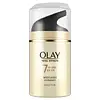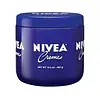What's inside
What's inside
 Key Ingredients
Key Ingredients

No key ingredients
 Benefits
Benefits

 Concerns
Concerns

 Ingredients Side-by-side
Ingredients Side-by-side

Water
Skin ConditioningGlycerin
HumectantNiacinamide
SmoothingIsohexadecane
EmollientDimethicone
EmollientIsopropyl Isostearate
EmollientStearyl Alcohol
EmollientPanthenol
Skin ConditioningTocopheryl Acetate
AntioxidantSodium Ascorbyl Phosphate
AntioxidantRetinyl Propionate
Skin ConditioningCamellia Sinensis Leaf Extract
AntimicrobialBHT
AntioxidantC13-14 Isoparaffin
EmollientCaprylyl Glycol
EmollientDimethiconol
EmollientLaureth-7
EmulsifyingCetearyl Glucoside
EmulsifyingCetearyl Alcohol
EmollientStearic Acid
CleansingPalmitic Acid
EmollientCetyl Alcohol
EmollientBehenyl Alcohol
EmollientDisodium EDTA
Polyacrylamide
PEG-100 Stearate
Titanium Dioxide
Cosmetic Colorant1,2-Hexanediol
Skin ConditioningPhenoxyethanol
PreservativeParfum
MaskingCI 19140
Cosmetic ColorantCI 16035
Cosmetic ColorantWater, Glycerin, Niacinamide, Isohexadecane, Dimethicone, Isopropyl Isostearate, Stearyl Alcohol, Panthenol, Tocopheryl Acetate, Sodium Ascorbyl Phosphate, Retinyl Propionate, Camellia Sinensis Leaf Extract, BHT, C13-14 Isoparaffin, Caprylyl Glycol, Dimethiconol, Laureth-7, Cetearyl Glucoside, Cetearyl Alcohol, Stearic Acid, Palmitic Acid, Cetyl Alcohol, Behenyl Alcohol, Disodium EDTA, Polyacrylamide, PEG-100 Stearate, Titanium Dioxide, 1,2-Hexanediol, Phenoxyethanol, Parfum, CI 19140, CI 16035
 Reviews
Reviews

Ingredients Explained
These ingredients are found in both products.
Ingredients higher up in an ingredient list are typically present in a larger amount.
Glycerin is already naturally found in your skin. It helps moisturize and protect your skin.
A study from 2016 found glycerin to be more effective as a humectant than AHAs and hyaluronic acid.
As a humectant, it helps the skin stay hydrated by pulling moisture to your skin. The low molecular weight of glycerin allows it to pull moisture into the deeper layers of your skin.
Hydrated skin improves your skin barrier; Your skin barrier helps protect against irritants and bacteria.
Glycerin has also been found to have antimicrobial and antiviral properties. Due to these properties, glycerin is often used in wound and burn treatments.
In cosmetics, glycerin is usually derived from plants such as soybean or palm. However, it can also be sourced from animals, such as tallow or animal fat.
This ingredient is organic, colorless, odorless, and non-toxic.
Glycerin is the name for this ingredient in American English. British English uses Glycerol/Glycerine.
Learn more about GlycerinPanthenol is a common ingredient that helps hydrate and soothe the skin. It is found naturally in our skin and hair.
There are two forms of panthenol: D and L.
D-panthenol is also known as dexpanthenol. Most cosmetics use dexpanthenol or a mixture of D and L-panthenol.
Panthenol is famous due to its ability to go deeper into the skin's layers. Using this ingredient has numerous pros (and no cons):
Like hyaluronic acid, panthenol is a humectant. Humectants are able to bind and hold large amounts of water to keep skin hydrated.
This ingredient works well for wound healing. It works by increasing tissue in the wound and helps close open wounds.
Once oxidized, panthenol converts to pantothenic acid. Panthothenic acid is found in all living cells.
This ingredient is also referred to as pro-vitamin B5.
Learn more about PanthenolParfum is a catch-all term for an ingredient or more that is used to give a scent to products.
Also called "fragrance", this ingredient can be a blend of hundreds of chemicals or plant oils. This means every product with "fragrance" or "parfum" in the ingredients list is a different mixture.
For instance, Habanolide is a proprietary trade name for a specific aroma chemical. When used as a fragrance ingredient in cosmetics, most aroma chemicals fall under the broad labeling category of “FRAGRANCE” or “PARFUM” according to EU and US regulations.
The term 'parfum' or 'fragrance' is not regulated in many countries. In many cases, it is up to the brand to define this term.
For instance, many brands choose to label themselves as "fragrance-free" because they are not using synthetic fragrances. However, their products may still contain ingredients such as essential oils that are considered a fragrance by INCI standards.
One example is Calendula flower extract. Calendula is an essential oil that still imparts a scent or 'fragrance'.
Depending on the blend, the ingredients in the mixture can cause allergies and sensitivities on the skin. Some ingredients that are known EU allergens include linalool and citronellol.
Parfum can also be used to mask or cover an unpleasant scent.
The bottom line is: not all fragrances/parfum/ingredients are created equally. If you are worried about fragrances, we recommend taking a closer look at an ingredient. And of course, we always recommend speaking with a professional.
Learn more about ParfumWater. It's the most common cosmetic ingredient of all. You'll usually see it at the top of ingredient lists, meaning that it makes up the largest part of the product.
So why is it so popular? Water most often acts as a solvent - this means that it helps dissolve other ingredients into the formulation.
You'll also recognize water as that liquid we all need to stay alive. If you see this, drink a glass of water. Stay hydrated!
Learn more about Water